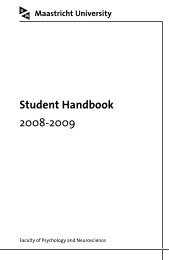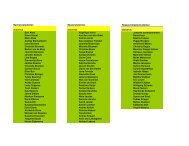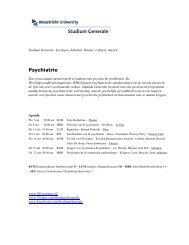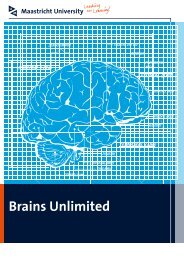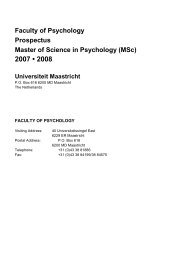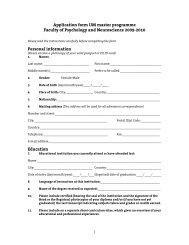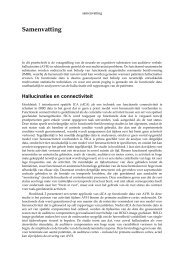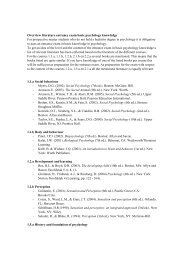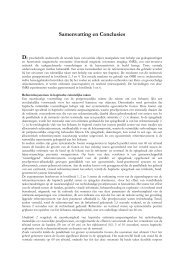Prospectus | 08/09 - Psychology and Neuroscience - Maastricht ...
Prospectus | 08/09 - Psychology and Neuroscience - Maastricht ...
Prospectus | 08/09 - Psychology and Neuroscience - Maastricht ...
Create successful ePaper yourself
Turn your PDF publications into a flip-book with our unique Google optimized e-Paper software.
<strong>Prospectus</strong> Research Master <strong>Psychology</strong> 20<strong>08</strong> • 20<strong>09</strong><br />
36<br />
brain. It is essential to have a basic knowledge of the brain anatomy when working in<br />
the field of neuropsychology or neurobiology. Many specific brain areas can be linked<br />
to particular functions. Thus, knowledge of the brain anatomy <strong>and</strong> its main functions<br />
allows one to directly link specific neurological or psychiatric disorders to particular<br />
brain areas. After a short theoretical introduction the students will study whole<br />
brains <strong>and</strong> brain material of mammals at both macroscopical (visual inspection) <strong>and</strong><br />
microscopical level. The emphasis will be on major brain systems including the basal<br />
ganglia <strong>and</strong> limbic system.<br />
Instructional Approach<br />
Almost exclusively practical: dissection of sheep brain, studying of microscopical<br />
slices of rat brain, working with plastic human brain models, CD-ROM programs <strong>and</strong><br />
textbook.<br />
Form of Assessment<br />
Pass/fail score based on written exam with open questions.<br />
| 424CN Programming in Matlab Basic Course– 2 credits<br />
Coordinator: Giancarlo Valente, Cognitive <strong>Neuroscience</strong> (FPN) , Phone 38 82469,<br />
40 Universiteitssingel East, Room 4.747, E-mail: giancarlo.valente@psychology.unimaas.nl<br />
Description of the Course<br />
Matlab is a powerful environment for numerical computation, data analysis <strong>and</strong><br />
visualization. It is, in essence, a programming language that has built in primitives<br />
for common scientific tasks that require many operations in other languages, such as<br />
C or Pascal. Examples are tasks such as matrix algebra (used in statistical analysis of<br />
data), Fourier transforms (used in signal processing), or 2D or 3D plots for visualization<br />
of data or analysis-results. Many complete packages for the analysis of cognitive<br />
neuroimaging data (e.g., fMRI data or EEG/MEG data) are implemented in Matlab.<br />
Thus, usage of these packages requires at least a basic underst<strong>and</strong>ing of Matlab.<br />
Furthermore, if more advanced analysis or visualization is needed that is not offered<br />
by existing packages, developing such new functionality in Matlab is often the most<br />
convenient option. The first part of the course will deal with algebra <strong>and</strong> matrix<br />
decompositions as an introduction to how Matlab primarily represent <strong>and</strong> processes<br />
data: as matrices. Subsequently, we study in detail the usage of the environment: the<br />
prompt, the workspace, getting help, loading, saving <strong>and</strong> visualizing data. We introduce<br />
the principles behind programming, with particular emphasis on neuroimaging<br />
applications.<br />
Instructional Approach<br />
Lectures, computer sessions combined in an interactive format.<br />
Form of Assessment<br />
Programming exercises throughout the training <strong>and</strong> assignments.



